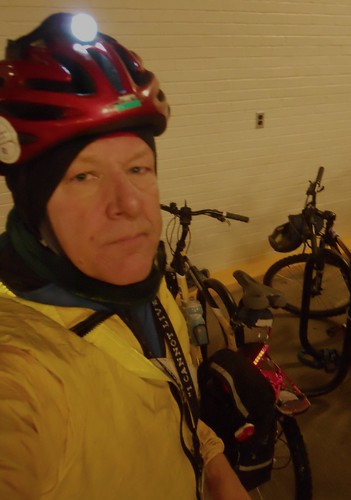When the first diamond frame bicycles became popular in the 1890s they were often called "wheels" - the national cycling association was called the "League of American Wheelmen." We have moved from "wheels" to "bikes," but the bicycles have remained remarkably the same over more than 100 years - elegant in their efficiency and simplicity. And many of the issues that we think are new? They were around then too.
Showing posts with label commuting. Show all posts
Showing posts with label commuting. Show all posts
Wednesday, March 4, 2015
Stop and Smell the Cherry Blossoms ! No Wait ......
Stopped on commute home at tidal basis edge, under cherry trees, to take this
The motorists were beeping at one another trying to escape the city before the next snow storm, but I was able to stop and take this of the fog over the tidal basis, which is unusual.
What looks to be something on my lens is a jet flying over the Memorial, having left National Airport.
Monday, February 23, 2015
Back to Bicycle Commuting
Mount Vernon Trail bridge near National Airport - solid ice
Last week Monday was a holiday and the government (and my job) were closed due to weather. The remainder of the week I went to work by Metro. It was the first week when I worked the "full week" (or as much as was available to work) and didn't ride one single day to work on my bicycle. Ugh.
Today I took my heavy yellow monster and rode to work. The trails in Arlington and roads in DC were fine, but the Mount Vernon Trail was not great. In the morning some of it was slushy, which presents traction issues if you slow down. The temperature fell during the day and most of the way was frozen solid on the way home. I ended up riding more than I would ever do otherwise using the small ring on the front of this old mountain bike, spinning very slowly in the lowest possible gear.
This bike has 1.95 inch wide mountain tires that have studs - amazingly it is possible to ride along at a slow steady pace on conditions like this bridge without difficulty - frozen ruts are the biggest problem.
Since I stopped to take some pictures and stopped somewhere else to talk to a guy and generally was riding pretty slowly, it took me close to an hour and a half to do what should take 45 minutes at most in regular weather.
An odd trade off with tire pressure - I ran with the tires at 50 pounds per square inch, which is somewhat too soft for the miles where the roads or asphalt trails are bare but is certainly too hard for conditions like what is in the photograph. A compromise, but not a great one.
Somewhat embarrassingly I will take Metro again tomorrow, because it will be colder and I think I am up for this every other day but not every day.
Where is spring?!?
Friday, January 9, 2015
Studded Tire Performance in Icy Weather
Photo from several years ago, but bike and tires look same now
I have a 15+ year old heavy ChroMoly Giant mountain bike with studded mountain bike tires - they were sold under the NashBar brand, but were made by Kenda (I think). 1.95 (or really 2) inches wide. There are two rows of studs, kind of alternating in position relative to one another looking across the tire. They are far enough out from the center of the tire that one can significantly influence how many studs may be in contact with the ground by changes in the tire pressure.
Three days ago it was snow, not ice, and I had the tires at 55 pounds per square inch. I made pretty good time but the studs were not really necessary. Two days ago the conditions were much more icy for about half the ride, in other words, the part that is NOT MAINTAINED BY THE NATIONAL PARK SERVICE (unlike Arlington County, which pretreats its bike trails, God help us). I rode to and from work with the tires inflated only to 40 pounds per square inch and clearly that improved the studly-stickiness of the tires - very little sliding around. On the other hand, on bare pavement, the road resistance is pretty noticeable (and unpleasant). A compromise.
Typical Mount Vernon Trail conditions - thanks for nothing, NPS
This morning I increased the pressure to 50 pounds per square inch since I was hopeful that the trails would be more clear today, but there were still significant areas that were covered from one side of the trail to the other. 50 pounds per square inch was too much to have the same kind of good traction that 40 provides, but I chose to ride along the edges of the trails where there was less bare ice or in a few cases off on the frozen ground along the trail. The improvement in rolling resistance by having more air in the tires made up for a small amount of slow riding in the few really bad spots.
I have now had these studded tires for something like eight years - maybe more. Of course there was at least one year where I didn't use them at all, but I don't ride them much. Originally I thought that if I rode what must be cheap metal studs on lots of bare pavement that I would pound them flat (ruin them) in no time, but in fact they seem to show little wear at all.
Last year I realized that I had lost several on each tire - they are kind of like short thick nails, with a head at the opposite end from what sticks out of the tire. Nashbar sells replacement studs with a tool for installing them and that works fine. I am now riding with a full complement of studs.
I see that there are road tires with studs - the rows of studs are of course much closer to each other. I assume that overall in most urban conditions these would be faster but for now I will stick with the mountain bike approach.
Saturday, October 18, 2014
Surprising DC 1922 News Photo of Everyday Bike Commuter
Surprise find, photo of a Washington DC bicycle commuter in 1922
The Washington Herald., October 01, 1922, Sunday Edition, Page 7
chroniclingamerica.loc.gov/lccn/sn83045433/1922-10-01/ed-...
"Miss M. Kearns, an employe of the Interior Department, has ridden her bicycle to the office daily for the past twenty years."
And later I find, by chance . . .
Same photograph, deposited by photographer Underwood & Underwood at the Library of Congress and online
Title: Woman rides bicycle for 25 years
Date Created/Published: c1922 Sept. 16.
Medium: 1 photographic print.
Summary: Miss M. Kearns with bicycle.
Reproduction Number: LC-USZ62-68742 (b&w film copy neg.)
Rights Advisory: No known restrictions on publication.
Call Number: SSF - Bicycles and tricycles [item] [P&P]
Repository: Library of Congress Prints and Photographs Division Washington, D.C. 20540 USA
Notes:
* Photo copyrighted by Underwood & Underwood.
* This record contains unverified, old data from caption card.
* Caption card tracings: Photog. I.; BI; Bicycles...; Shelf.
Tuesday, March 18, 2014
Walking the 14th St Bridge (on the Way to Work)

Doesn't look too bad . . .
I used my "ice & snow" bike and was reminded it is better with ice and less good with some snow conditions. Most of the ride the asphalt trails were much more clear than I expected and with my studded tires I chugged along steadily. But the 14th St Bridge pedestrian/bicycle area was 3-4 inches of mush (not slush, but mush) that was hard to maintain forward motion with given the 2 inch wide tires and a desire not to spin the wheels (which could pull out studs, maybe) and the sort of wild steering required.
Anyway I ended up walking more than half the way since it was a more consistent level of effort and probably about the same speed as the stop-and-go approach with riding in my lowest gear.
Saturday, February 8, 2014
Bike Train Commuting?
Voice of America decides to report on a bike commuter innovation in L.A.
Voice of America, the "official external broadcast institution" of the United States, has an article (along with the video, above) about a way to make car-centric Los Angeles better for bicycle commuters.
To make cycling safer, some bicyclists in Los Angeles, who live and work near each other, are commuting together in what's called a “bike train.”
“You’re a big enough group that cars don’t have the same behaviors as if you are just one person," said Nona Varnado, who co-founded L.A. Bike Trains. "And you’re also with an experienced cyclist.”
L.A. Bike Trains launched in May 2013 and the number of participants and routes around the city has been growing.
“We specifically design each route so we avoid problem intersections,” Varnado said.
This has been going on since May 2013; it is described more fully on the L.A. Biketrain site.
"DOWNTOWN LOS ANGELES - When it comes to riding a bicycle, especially on city streets, the rule of safety in numbers applies. A group of cyclists pedaling at the same pace is simply more visible to car drivers. There’s another plus about riding in a group: It’s more fun.
I understand the concept but I think this is arguably a misapplication of the idea that there is "safety in numbers" with urban cycling. As cycling grows in a particular city or area, motorists get used to seeing more cyclists and interacting with them more successfully (that is, less dangerously for the cyclists). It appears there is some kind of threshold for this - it doesn't happen until you get enough cyclists out on the streets as a presence. The "bike trains" may be more people out riding (which is good) but it also presents motorists with something on the roads that they almost certainly don't like and won't know how to interact with, bicycles in a group - so that aspect seems more problematic. The statement, "cars don't have the same behaviors as if you are just one person" seems correct from my experience, but in the wrong way - motorists here seem much more inclined to get really annoyed with a group of cyclists riding in some way that they don't like than with just one. They can almost always easily figure out how to get around one.
Another problem from my personal perspective is that bicycle commuting is a delightfully independent activity, and to be part of a "bike train" you have to be on a schedule that syncs with the train's and so on. Perhaps I come at bicycle commuting all wrong, but being part of an organized "train" would take away much of the appeal.
On the other hand, whatever works? Sure.
This sort of group ride looks more pleasant and functional than trying to manage a commute as part of a group
Friday, January 24, 2014
Limits of Cold Weather Commuting
As in, my limits. Well, my limits and the limits of my cycling equipment.
My ice commuter, for better or worse
Today was the second day I rode back and forth the ten miles between my house and Capitol Hill with the trails pretty icy and in reasonably cold weather, particularly in the morning. In my years of commuting in more or less all weather, it is fairly unusual to have sustained cold such that the trail conditions didn't change that much between two days. In a few places some salt had cleared areas, but it was not like the second day was a huge improvement. (Mostly the trails are not treated.)
This morning it was cold, for here at least, at around 12-14 F - around -10 C. It was colder than yesterday and since it took me over an hour to get to work, my fingers were starting to get cold on one hand - but overall my cold weather biking clothes work OK at least down to this temp. But I need to keep moving, spinning, to maintain my warmth.
The bigger problem is with my bike and my fitness (my "fitness" in the broader sense of being physically ready for such an endeavor). The bike is an old Giant that I have only ridden in the last few years when I want to take advantage of the studded tires I have mounted on it, and that's it. The bike could use some adjustments. The rear brakes in particular don't work well in these conditions and of course when it is slick the front brake can't be used (much) without instantly causing a crash so the poor rear brake performance isn't helpful at all. (I should fix that!) The 1.95 inch wide tires with the studs are lovely for traction when the surface is mostly flat/smooth but if there is accumulated snow or snow+ice they have a terrific amount of road (or I guess snow) resistance - the width isn't helpful.
But it does work. Two days running I rode back and forth on a lot of slick surfaces and didn't fall once. And I got back and forth.
The Gravelly Point area of the Mount Vernon Trail; another riding north as I head south
I don't see too many other riders on the trail on a day like this. Today I saw two riders coming the other way on my ride home (total) - one was a commuter and the other fellow just seemed to be out enjoying the fun to be had. The photo above shows the commuter I saw, chugging along. He did not, I think, have studded tires - he was riding a cyclocross sort of 700 size tire bike and was hugging the right edge of the trail. I am familiar with this approach - basically you stay away from where other riders have been riding and especially stay away from icy sections. The narrow tires cut through the snow OK and you have traction but it very tiring to maintain this kind of straight-ish line.
My approach with the wide mountain bike tires is to stick to the middle where the snow is pounded flat and where there is compacted snow on ice and try to skirt as much of the clear ice as I can. The studded tires will allow some riding on clear ice, but you can't brake or steer (much). And sometimes you hit a bump and the bike simple slides. The studs aren't a perfect solution.
It's an adventure (or something like one, for me) but I'm glad to have the weekend now to rest up. I don't know if I could do more than two days running of this. I was unhappy this morning to pass a guy walking his bike on the Mount Vernon Trail near the airport, on one of the bridges - he had a very nice bike, but apparently was having no luck staying upright. He didn't look like he was dressed as warmly as me, and walking . . . I didn't have anything to help him with this problem, so I just kept going.
A snow-bike patent for a set of attachments from 1900 - but my problem was ice, alas
I have a sort of cyclocross bike that is presently out of commission with disk brakes - I should get some studded tires for that thing when they are on sale so I have a bike to ride in this kind of weather with working brakes and have narrower tires to cut through snow. For next year. Yeah.
My ice commuter, for better or worse
Today was the second day I rode back and forth the ten miles between my house and Capitol Hill with the trails pretty icy and in reasonably cold weather, particularly in the morning. In my years of commuting in more or less all weather, it is fairly unusual to have sustained cold such that the trail conditions didn't change that much between two days. In a few places some salt had cleared areas, but it was not like the second day was a huge improvement. (Mostly the trails are not treated.)
This morning it was cold, for here at least, at around 12-14 F - around -10 C. It was colder than yesterday and since it took me over an hour to get to work, my fingers were starting to get cold on one hand - but overall my cold weather biking clothes work OK at least down to this temp. But I need to keep moving, spinning, to maintain my warmth.
The bigger problem is with my bike and my fitness (my "fitness" in the broader sense of being physically ready for such an endeavor). The bike is an old Giant that I have only ridden in the last few years when I want to take advantage of the studded tires I have mounted on it, and that's it. The bike could use some adjustments. The rear brakes in particular don't work well in these conditions and of course when it is slick the front brake can't be used (much) without instantly causing a crash so the poor rear brake performance isn't helpful at all. (I should fix that!) The 1.95 inch wide tires with the studs are lovely for traction when the surface is mostly flat/smooth but if there is accumulated snow or snow+ice they have a terrific amount of road (or I guess snow) resistance - the width isn't helpful.
But it does work. Two days running I rode back and forth on a lot of slick surfaces and didn't fall once. And I got back and forth.
The Gravelly Point area of the Mount Vernon Trail; another riding north as I head south
I don't see too many other riders on the trail on a day like this. Today I saw two riders coming the other way on my ride home (total) - one was a commuter and the other fellow just seemed to be out enjoying the fun to be had. The photo above shows the commuter I saw, chugging along. He did not, I think, have studded tires - he was riding a cyclocross sort of 700 size tire bike and was hugging the right edge of the trail. I am familiar with this approach - basically you stay away from where other riders have been riding and especially stay away from icy sections. The narrow tires cut through the snow OK and you have traction but it very tiring to maintain this kind of straight-ish line.
My approach with the wide mountain bike tires is to stick to the middle where the snow is pounded flat and where there is compacted snow on ice and try to skirt as much of the clear ice as I can. The studded tires will allow some riding on clear ice, but you can't brake or steer (much). And sometimes you hit a bump and the bike simple slides. The studs aren't a perfect solution.
It's an adventure (or something like one, for me) but I'm glad to have the weekend now to rest up. I don't know if I could do more than two days running of this. I was unhappy this morning to pass a guy walking his bike on the Mount Vernon Trail near the airport, on one of the bridges - he had a very nice bike, but apparently was having no luck staying upright. He didn't look like he was dressed as warmly as me, and walking . . . I didn't have anything to help him with this problem, so I just kept going.
A snow-bike patent for a set of attachments from 1900 - but my problem was ice, alas
I have a sort of cyclocross bike that is presently out of commission with disk brakes - I should get some studded tires for that thing when they are on sale so I have a bike to ride in this kind of weather with working brakes and have narrower tires to cut through snow. For next year. Yeah.
Wednesday, January 8, 2014
Bicycle Commuting & the "Polar Vortex" (in DC)
So, Tuesday January 7, the temperature when I would normally take off to work on a bicycle was around 8 Fahrenheit. (Apparently that is around -13 Celsius.) Also it was windy, although thankfully not too windy, and not directly from the north.
If I had any sense, I would use Metro. Apparently I don't have any sense. And I have all this biking stuff I have accumulated over the years - surely if I put it all on, I would be able to ride in this weather? In my mind, I had drawn a line at about 10-15 degrees F - below that, stop riding. But I have purchased still more stuff, so perhaps 8 was OK. This would be the coldest weather I have ridden to work in.
In front of work, having arrived - I don't look so good, as a matter of fact
I managed to get there, but I can't say I enjoyed it much. Neither my toes nor my fingers got cold, so the clothes worked OK (I guess). Here is what I wore, from head to toe:
* (Cheap) hiking boots - I have some low-rise boots that are not intended for cycling (at all) that are not "breathable" (due to their cheap design) and therefore are windproof. I swap my usual pedals for platform pedals so I can use these.
* Odd polypropylene "cycling" socks for cold weather - I bought these odd things from Performance some years ago and they do a good job of keeping heat in and cold out, but they don't breath (moisture) at all, so are only really useful when it is really cold.
* Two pairs of wool socks - not real heavy ones, but two pair.
* regular bicycle fitted shorts.
* Cycling cold weather windproof tights.
* Regular cycling tights on top of the other tights.
* A pair of shorts.
* Medium sleeve fitted bicycle wool base layer shirt thing.
* Long sleeve fitted bicycle wool base layer shirt thing on top of that.
* Long sleeve wool cycling jersey (old style).
* Long sleeve lycra cycling jersey with hood built in.
* Short sleeve lycra cycling jersey.
* Polyfill vest
* Cycling windbreaker that is truly windproof.
* Pair of full gloves with fingers.
* Pair of "lobster" gloves (thumb plus two compartments for fingers in pairs) over the other gloves.
* Polar fleece watch cap thing.
* Some other watch cap over that (and over the hood of one of the shirts)
* Wool scarf pulled tight over face, up to below eye level.
There you go!
If I had any sense, I would use Metro. Apparently I don't have any sense. And I have all this biking stuff I have accumulated over the years - surely if I put it all on, I would be able to ride in this weather? In my mind, I had drawn a line at about 10-15 degrees F - below that, stop riding. But I have purchased still more stuff, so perhaps 8 was OK. This would be the coldest weather I have ridden to work in.
In front of work, having arrived - I don't look so good, as a matter of fact
I managed to get there, but I can't say I enjoyed it much. Neither my toes nor my fingers got cold, so the clothes worked OK (I guess). Here is what I wore, from head to toe:
* (Cheap) hiking boots - I have some low-rise boots that are not intended for cycling (at all) that are not "breathable" (due to their cheap design) and therefore are windproof. I swap my usual pedals for platform pedals so I can use these.
* Odd polypropylene "cycling" socks for cold weather - I bought these odd things from Performance some years ago and they do a good job of keeping heat in and cold out, but they don't breath (moisture) at all, so are only really useful when it is really cold.
* Two pairs of wool socks - not real heavy ones, but two pair.
* regular bicycle fitted shorts.
* Cycling cold weather windproof tights.
* Regular cycling tights on top of the other tights.
* A pair of shorts.
* Medium sleeve fitted bicycle wool base layer shirt thing.
* Long sleeve fitted bicycle wool base layer shirt thing on top of that.
* Long sleeve wool cycling jersey (old style).
* Long sleeve lycra cycling jersey with hood built in.
* Short sleeve lycra cycling jersey.
* Polyfill vest
* Cycling windbreaker that is truly windproof.
* Pair of full gloves with fingers.
* Pair of "lobster" gloves (thumb plus two compartments for fingers in pairs) over the other gloves.
* Polar fleece watch cap thing.
* Some other watch cap over that (and over the hood of one of the shirts)
* Wool scarf pulled tight over face, up to below eye level.
There you go!
Tuesday, December 3, 2013
Four Mile Run Bicycle Detour - A Coming Distraction
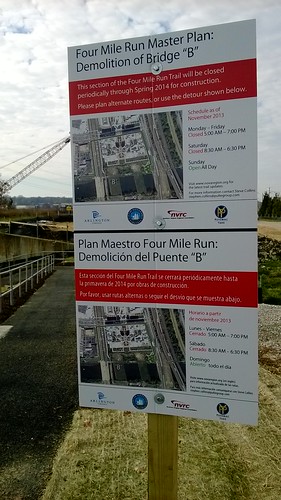
One of several signs announcing the detour
A detour was supposed to start on in my bicycle commute, but the demolition must be behind since it hasn't happened as of December 2nd (2013) per announcements.
Four Mile Run Potomac Yard Bridge Demolition Updates
As of today, this is what the text says:
Starting December 2nd and running for approximately 6 months, a short section of the Four Mile Run trail in Potomac Yard near the junction with the Mt. Vernon Trail will be closed during most commuting hours due to demolition of a bridge overhead.I have given it some thought, and for most people there aren't workable alternate routes that don't add significantly to the distance or that you use surface streets through Crystal City, which means that you ride on (ugh) surface streets. Well, whatever, as they say. It continues ~
A detour will be provided, but many riders may find it better to pick an alternate route to avoid the construction area altogether.
The detour - designed for ADA compliance, not necessarily bicycles - diverts traffic off of the trail onto the Jeff Davis Hwy west side sidewalk and also at the new switchback ramps to cross US1 at the S. Glebe Road signal. For those who are game, the switchback does incorporate a flight of stairs with bike rails built in.I find this part quite annoying. The "switchback ramps" are not "not necessarily [for] bicycles" but absolutely not for bicycles, if they mean while being ridden. And the "bike rails" are simply boards butted up against the railing, not trough-style rails that guide the bike properly up and down the stairs. Pitiful. "If you are game" - what's that about? It is either OK or it isn't OK. It isn't OK.

Above is a screen grab from a video from Arlington County that shows the switchbacks while under construction (although it is not, in fact, in Arlington County)
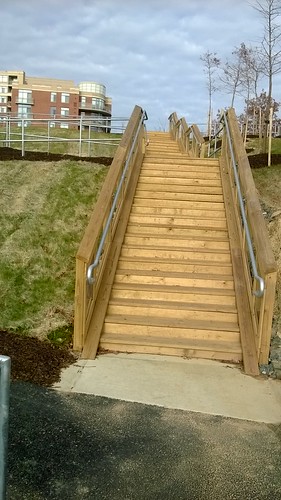
The stairs that is part of the detour, with the so-called "bike rails"
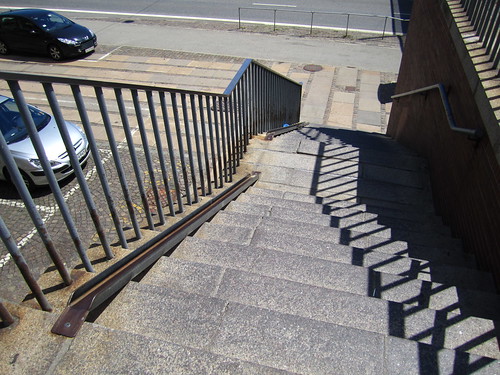
This image shows what a proper bike rail looks like
Thursday, July 18, 2013
"He Jumped" - 14th St Bridge Commute
This week has been pretty warm in the DC area - leaving my house to ride in at 6:30 it has already been 80 degrees (27 C) or higher and fairly humid. I consider these "two bottle" days since instead of just one bottle of Gatorade, I have two bottles, one of which I take frozen from the freezer - by the time I am half way to work, it is drinkable and I'll finish it before arriving.
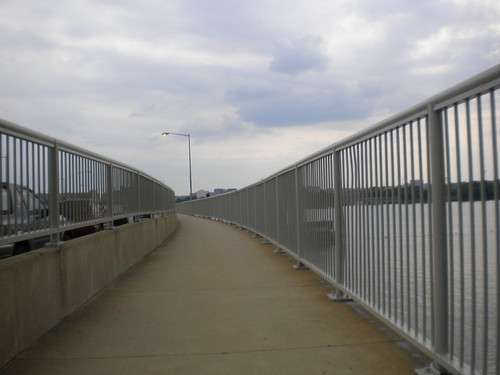
Taken a different day and of the other end of the bridge, this gives a sense the layout of the pedestrian area on the bridge
This morning I got to the 14th St Bridge that connects Arlington to Washington around 7 AM. Riding onto the bridge, I am on the fenced in pedestrian area that is for foot and bicycle traffic in both directions - it isn't terribly wide given how many cyclists use it these days. About 100 yards (meters) on to the bridge, I saw a backpack sitting on one side, more or less blocking bicycle traffic heading towards me. I have noticed that I don't necessarily transition from "bike thinking" that is mostly reactive and instinctive to other problem solving; anyway, a woman outbound stopped next to the backpack and said something and I shot by in the other direction - then after about ten yards, stopped, turned around, and went back.
"He jumped off the bridge," she said. I was stunned - what?!? This bridge may be 50-60 feet (20 meters) above the water, so as a suicide jumpoff location it isn't suitable, so to speak. And for that reason, one assumes, the fence keeping one from jumping off is fairly low (as shown in the photo). I had not seen this, but the woman had seen some guy who put down his backpack and promptly climbed up and jumped over, just as I approached from the other direction. (How I didn't see this, I still don't understand.) Sitting next to his backpack was his wallet, almost ready to slip over the edge under the rail into the Potomac.
We look over - we see nothing. No guy. So, I mean, what is one to do? A guy drops his stuff and jumps off a bridge, so you call 911. So I did. The 911 operator and I did not have a terribly successful conversation - she seemed amazingly unaware of how the 14 St bridges (there are five of them, including rail bridges) are laid out. Eventually she said that (a) she was sending the police, even though by now we could see the guy, happily swimming (remember, is was quite hot out) not below us but off to one side and studiously ignoring us, above, yelling at him, and (b) that I could leave this location and didn't need to wait for the police.
So I continued on my way to work. The woman, for whatever reason and I have no idea how long, stayed. I also don't know if the police really showed up, or what else happened.
I don't know what my lesson-learned from this bizarre experience was. I mean, sure it was hot, so taking a swim in the Potomac may be a semi-sensible thing to do, but leaping off a bridge in rush hour and leaving all that stuff behind where it isn't exactly possible to keep track of it? So my guessing he just wanted to cool off would be a little counter-intuitive. I think.
I ride by a cyclist who is stopped along the trail on my commute, I ask, "got what you need?" I have given away a couple of inner tubes and pumped up a few tires, and of course encountered any number of situations where I could be no help whatsoever (since I only care so many tools in my little tool bag). Hmm.

Taken a different day and of the other end of the bridge, this gives a sense the layout of the pedestrian area on the bridge
This morning I got to the 14th St Bridge that connects Arlington to Washington around 7 AM. Riding onto the bridge, I am on the fenced in pedestrian area that is for foot and bicycle traffic in both directions - it isn't terribly wide given how many cyclists use it these days. About 100 yards (meters) on to the bridge, I saw a backpack sitting on one side, more or less blocking bicycle traffic heading towards me. I have noticed that I don't necessarily transition from "bike thinking" that is mostly reactive and instinctive to other problem solving; anyway, a woman outbound stopped next to the backpack and said something and I shot by in the other direction - then after about ten yards, stopped, turned around, and went back.
"He jumped off the bridge," she said. I was stunned - what?!? This bridge may be 50-60 feet (20 meters) above the water, so as a suicide jumpoff location it isn't suitable, so to speak. And for that reason, one assumes, the fence keeping one from jumping off is fairly low (as shown in the photo). I had not seen this, but the woman had seen some guy who put down his backpack and promptly climbed up and jumped over, just as I approached from the other direction. (How I didn't see this, I still don't understand.) Sitting next to his backpack was his wallet, almost ready to slip over the edge under the rail into the Potomac.
We look over - we see nothing. No guy. So, I mean, what is one to do? A guy drops his stuff and jumps off a bridge, so you call 911. So I did. The 911 operator and I did not have a terribly successful conversation - she seemed amazingly unaware of how the 14 St bridges (there are five of them, including rail bridges) are laid out. Eventually she said that (a) she was sending the police, even though by now we could see the guy, happily swimming (remember, is was quite hot out) not below us but off to one side and studiously ignoring us, above, yelling at him, and (b) that I could leave this location and didn't need to wait for the police.
So I continued on my way to work. The woman, for whatever reason and I have no idea how long, stayed. I also don't know if the police really showed up, or what else happened.
I don't know what my lesson-learned from this bizarre experience was. I mean, sure it was hot, so taking a swim in the Potomac may be a semi-sensible thing to do, but leaping off a bridge in rush hour and leaving all that stuff behind where it isn't exactly possible to keep track of it? So my guessing he just wanted to cool off would be a little counter-intuitive. I think.
I ride by a cyclist who is stopped along the trail on my commute, I ask, "got what you need?" I have given away a couple of inner tubes and pumped up a few tires, and of course encountered any number of situations where I could be no help whatsoever (since I only care so many tools in my little tool bag). Hmm.
Sunday, June 30, 2013
Comparing Cycling in the U.S. and the Netherlands - Valid?
I am reading In the City of Bikes: The Story of the Amsterdam Cyclist" that turns out to be more of a history of this subject and less of a memoir than I was expecting. I will write a review of it when I am finished.
As someone who reads and thinks about how cycling could be better supported in the U.S., the Netherlands comes up as a model often, although I have to wonder about its validity as such. In some cases, people make comparisons or talk about aspects of cycling in the Netherlands and it isn't clear if they are holding the Netherlands approach up as a model or simply an example of how it can be different than it is here. The later seems more useful to me since the likelihood of our ending up with anything vaguely like what the Netherlands has to support urban (and interurban) cycling absent their 100+ history in this area along (not to mention all the other factors) seems rather low.
With that in mind, however, it can be interesting to look at examples of this "conversation."
Cycling in the US from a Dutch perspective from this blogger
The above video provides a quick understanding of how at least one Dutch cyclist views the American approach to cycling. I don't disagree with any of this analysis as such but in a short overview like this he presumably includes those points that he considers most significant and leaves others out. In my own experience, it has been difficult to transition from an automobile-centered way of thinking to actually using bicycles for more routine day-to-day transportation needs. I have several bikes that I use for commuting the 20 miles round trip (~34 km) to and from work, but these bikes have pedals requiring special shoes and as road bikes are not very good for riding a mile to the grocery store or library for those kinds of errands. So for many years I have ridden a bike consistently to and from work over a fairly long distance, with special clothing and appearing to be in a great hurry (since this doubles as my exercise program) but then I drive very short distances to do things where I would want to arrive wearing street clothes. Kind of strange.
Recently I have started using another bike that is a much more upright one, with a three speed hub shift (and therefore incapable of speedsterish activity), to ride back and forth to places a mile or less away to do errands, without changing into some special cycling clothes. I have been surprised and I suppose a little amused at how enjoyable this is.
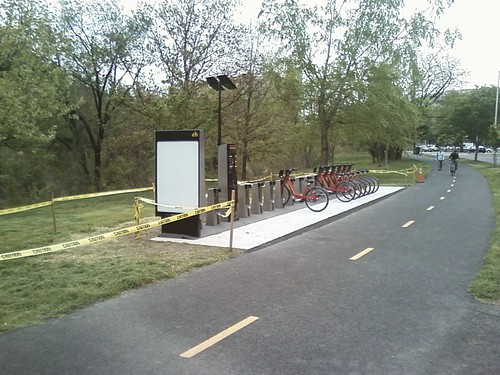
Capital Bikeshare arrives in my extendedneighborhood, but closer to my typical destination for short rides-still, nice to have it around
In a roundabout way of thinking, I feel that bikeshare programs, such as the Capital Bikeshare program here in the Washington DC area, are very helpful with modeling and enabling this kind of cycling.
"Infamous" video of bicycle commuters at an intersection in Ultrecht (not Amsterdam) illustrating the level of cycling in an urban setting in the Netherlands
This video serves as a counterpoint to the first video looking at cycling in the U.S., illustrating the significant differences in the scale of cycling as an activity. While I don't think the Netherlands can be our "model" for where we want cycling in the U.S. to end up, it certainly illustrates that cycling on a scale that rivals and even exceeds use of motor vehicles is possible and that specialized infrastructure (or as the video's narrator says, "infra") can be created to support that level of activity. (It's noteworthy that the Dutch observer in his video takes the benefits of specialized infrastructure to support cycling as a given - no "vehicular cycling" for him.)
It's also interesting to see how the Dutch cyclists comply with their traffic signals in this video, for the most part. At a few points there are riders who ignore the light, but the vast majority comply.
This syncs with a recent report that in Portland stoplight cameras studied showed that there was 94 percent compliance with stop lights by cyclists. What?? Really?? Yes. Of course the obvious reason for why this could be true in Portland (and not quite what I observe around here) is that they have a larger number of cyclists and that as a community they act to informally enforce or support good (or anyway legal) behavior while in situations that I see often here of one or two cyclists and a zillion cars, it is much more tempting or attractive not to.
As someone who reads and thinks about how cycling could be better supported in the U.S., the Netherlands comes up as a model often, although I have to wonder about its validity as such. In some cases, people make comparisons or talk about aspects of cycling in the Netherlands and it isn't clear if they are holding the Netherlands approach up as a model or simply an example of how it can be different than it is here. The later seems more useful to me since the likelihood of our ending up with anything vaguely like what the Netherlands has to support urban (and interurban) cycling absent their 100+ history in this area along (not to mention all the other factors) seems rather low.
With that in mind, however, it can be interesting to look at examples of this "conversation."
Cycling in the US from a Dutch perspective from this blogger
The above video provides a quick understanding of how at least one Dutch cyclist views the American approach to cycling. I don't disagree with any of this analysis as such but in a short overview like this he presumably includes those points that he considers most significant and leaves others out. In my own experience, it has been difficult to transition from an automobile-centered way of thinking to actually using bicycles for more routine day-to-day transportation needs. I have several bikes that I use for commuting the 20 miles round trip (~34 km) to and from work, but these bikes have pedals requiring special shoes and as road bikes are not very good for riding a mile to the grocery store or library for those kinds of errands. So for many years I have ridden a bike consistently to and from work over a fairly long distance, with special clothing and appearing to be in a great hurry (since this doubles as my exercise program) but then I drive very short distances to do things where I would want to arrive wearing street clothes. Kind of strange.
Recently I have started using another bike that is a much more upright one, with a three speed hub shift (and therefore incapable of speedsterish activity), to ride back and forth to places a mile or less away to do errands, without changing into some special cycling clothes. I have been surprised and I suppose a little amused at how enjoyable this is.

Capital Bikeshare arrives in my extendedneighborhood, but closer to my typical destination for short rides-still, nice to have it around
In a roundabout way of thinking, I feel that bikeshare programs, such as the Capital Bikeshare program here in the Washington DC area, are very helpful with modeling and enabling this kind of cycling.
"Infamous" video of bicycle commuters at an intersection in Ultrecht (not Amsterdam) illustrating the level of cycling in an urban setting in the Netherlands
This video serves as a counterpoint to the first video looking at cycling in the U.S., illustrating the significant differences in the scale of cycling as an activity. While I don't think the Netherlands can be our "model" for where we want cycling in the U.S. to end up, it certainly illustrates that cycling on a scale that rivals and even exceeds use of motor vehicles is possible and that specialized infrastructure (or as the video's narrator says, "infra") can be created to support that level of activity. (It's noteworthy that the Dutch observer in his video takes the benefits of specialized infrastructure to support cycling as a given - no "vehicular cycling" for him.)
It's also interesting to see how the Dutch cyclists comply with their traffic signals in this video, for the most part. At a few points there are riders who ignore the light, but the vast majority comply.
This syncs with a recent report that in Portland stoplight cameras studied showed that there was 94 percent compliance with stop lights by cyclists. What?? Really?? Yes. Of course the obvious reason for why this could be true in Portland (and not quite what I observe around here) is that they have a larger number of cyclists and that as a community they act to informally enforce or support good (or anyway legal) behavior while in situations that I see often here of one or two cyclists and a zillion cars, it is much more tempting or attractive not to.
Saturday, January 26, 2013
Cracked Rim & Brake "Dirt"
Riding in snow and ice even with studded tires can be challenging - also if one has any sense, it is important to clean up the bike fairly soon after to get the road salt mix residue off the bike. Wheel spokes in particular are vulnerable to the corrosive effects of that stuff; I am embarrassed (I guess) to admit that one year I rode in some bad weather and then parked the bike in my shed and forgot to clean it - much later I discovered the road glop had eaten its way into several spokes enough that when I gave them a wiggle, they snapped! Lesson learned. Ouch.

Crack discovered while cleaning the rim
So I took the old mountain bike (a Giant Boulder SE, more than ten years old) that I rode in the snow and cleaned it up and while cleaning the rear wheel I found that therim had a crack in it. Aggh! What I actually had found, as revealed in a helpful comment (below) is an artifact of the manufacturing process that I had not noticed before. Oops.
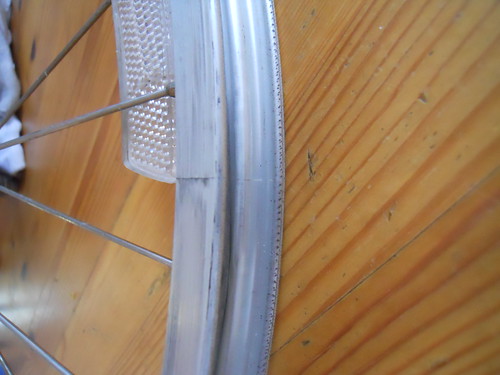
Not surprisingly the crack goes through to inside of rim
Fortunately I have another mountain bike around that I can borrow a wheel from, but I will have to buy a new wheel.

In gloppy weather, brakes make a mess of rims
I didn't need to clean the other side of the wheel now! You can see just how much of the brakes end up on the rims in sloppy weather. I suppose I could buy better brake pads, too.
Anyway, this provides something of an answer to the question of why one gets something better if you spend more on a bike. This is a perfectly OK entry level Giant mountain bike but aside from being fairly heavy none of the components are terribly good (although none are terrible, either). In short I am not particularly surprised to have a cracked wheel on a bike like this. The question arises, at least in my mind, of whether I now take back this comment about low cost bikes and their quality quotient. After some ten minutes of contemplation (intermittently) I guess I would have to say no. I don't.

Crack discovered while cleaning the rim
So I took the old mountain bike (a Giant Boulder SE, more than ten years old) that I rode in the snow and cleaned it up and while cleaning the rear wheel I found that the

Not surprisingly the crack goes through to inside of rim
Fortunately I have another mountain bike around that I can borrow a wheel from, but I will have to buy a new wheel.

In gloppy weather, brakes make a mess of rims
I didn't need to clean the other side of the wheel now! You can see just how much of the brakes end up on the rims in sloppy weather. I suppose I could buy better brake pads, too.
Anyway, this provides something of an answer to the question of why one gets something better if you spend more on a bike. This is a perfectly OK entry level Giant mountain bike but aside from being fairly heavy none of the components are terribly good (although none are terrible, either). In short I am not particularly surprised to have a cracked wheel on a bike like this. The question arises, at least in my mind, of whether I now take back this comment about low cost bikes and their quality quotient. After some ten minutes of contemplation (intermittently) I guess I would have to say no. I don't.
Friday, January 25, 2013
Snow Ride Home - Outrunning a Cervélo
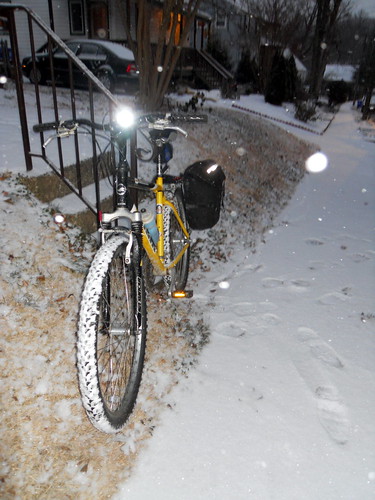
Snow-enabled old mountain bike with studded tires in front of house
There was a rather indefinite forecast that there might be snow this afternoon - so I rode this rather heavy old bike with studded mountain bike tires that are about two inches in diameter. If there is ice and snow, they are good to have, but this morning it was mostly clear, so the bike felt like a burden. However a couple of years ago I fell during a snow storm ride so I am trying to be more cautious.
Coming home I was glad to have this bike with its studded tires. The icy spots visible this morning were now covered in snow so it was harder to avoid them but with these tires it isn't necessary. I trundled along at a steady if slow pace. The most annoying aspect was the strong wind from the SW (or thereabouts) along the river.
Just on the DC side of the 14th St Bridge there was a rider in his sorta winter racing/training kit on a Cervélo who let me go ahead of him. Really, a Cervélo in the snow? So this will be the one time I completely drop a character on a bike like that. And while riding a heavy crap-cycle - that uh happens to have the right tires. So maybe not so crappy.
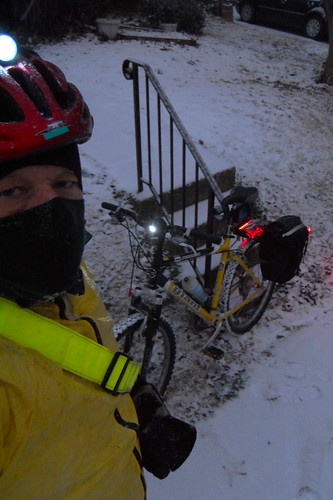
Made it home! Let the weekend begin ~
Thursday, January 24, 2013
At Work After First Snow Ride of Year
Sunday, December 30, 2012
Modern "Commuting Wool Top" (Shirt)
For Christmas I received a very nice cycling shirt, made of Merino wool by Bontrager (which is part of Trek). I was a little surprised - I didn't realize that they made anything like this. I googled the full name of the thing and found it on their site and in various outlets, although I get the impression it may be discontinued - it was half price at several places and on the Bontrager site I was unable to find it either using browse or their search.
Perhaps Bontrager couldn't figure out how to market what is quite useful simply as what it is - a wool cycling shirt. They seem to have wanted it to serve as a fashion statement "on and off the bike."
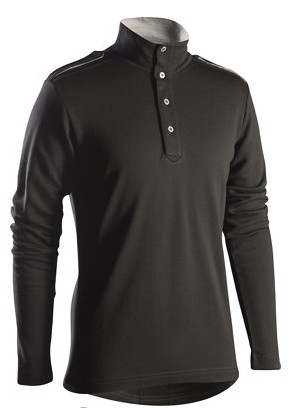
The Bontrager wool commuter "top" (shirt)
In the list of "features" they continue to focus more on form than function: "Midweight, casual, high-collar long sleeve wool top for short commutes and trendy destinations." The "high-collar" part is simply a collar designed with buttons so that it can be buttoned up to create a high collar for windy or cool conditions - clever. There is also a single buttoned pocket on the back, off to one side, since cyclists may not have pockets in their shorts.
Certain features are pointless or silly - yes, there is a reflective edge to the one pocket, but in the dark this would contribute effectively zero. Even stranger are the epaulettes - are those a fashion feature for the hipster (or whoever) at the pub, around the city, etc.? For men I associate epaulettes like these with tour bus drivers and the like. And I don't understand why they don't call it a shirt or a jersey instead of a "top."
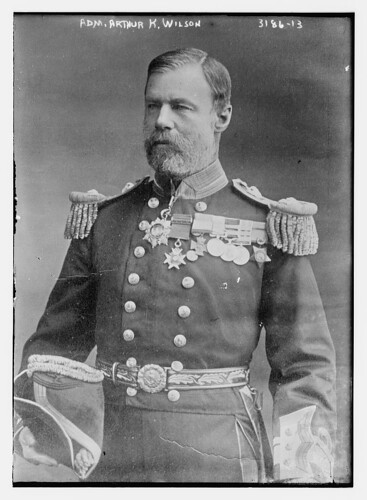
Now here are some epaulettes
The shirt is also a bit oddly sized, even by the standard of cycling clothing. I received and XL, which fits just right - but I am usually a medium for shirts, not large, so to have an XL fit is a little unusual. The site does say, "If you prefer a slightly roomier fit or are in-between sizes, consider ordering one size up" but this seems more than that - also the only sizes available are XL and XXL.
The MSRP is $79 which isn't that bad in my mind (given what I paid for a Merino wool "base layer" shirt last year) but it seems to be available from some outlets for half that, which seems a great deal.
Perhaps Bontrager couldn't figure out how to market what is quite useful simply as what it is - a wool cycling shirt. They seem to have wanted it to serve as a fashion statement "on and off the bike."
On the bike, to the office, to the market, to the pub, around the city. If that sounds like you, then the 100% merino wool long sleeve Commuting Wool Top has the go-anywhere fashion and on-bike performance you need to transition seamlessly from riding your bike to looking right at home, no matter where your bike takes you.

The Bontrager wool commuter "top" (shirt)
In the list of "features" they continue to focus more on form than function: "Midweight, casual, high-collar long sleeve wool top for short commutes and trendy destinations." The "high-collar" part is simply a collar designed with buttons so that it can be buttoned up to create a high collar for windy or cool conditions - clever. There is also a single buttoned pocket on the back, off to one side, since cyclists may not have pockets in their shorts.
Certain features are pointless or silly - yes, there is a reflective edge to the one pocket, but in the dark this would contribute effectively zero. Even stranger are the epaulettes - are those a fashion feature for the hipster (or whoever) at the pub, around the city, etc.? For men I associate epaulettes like these with tour bus drivers and the like. And I don't understand why they don't call it a shirt or a jersey instead of a "top."

Now here are some epaulettes
The shirt is also a bit oddly sized, even by the standard of cycling clothing. I received and XL, which fits just right - but I am usually a medium for shirts, not large, so to have an XL fit is a little unusual. The site does say, "If you prefer a slightly roomier fit or are in-between sizes, consider ordering one size up" but this seems more than that - also the only sizes available are XL and XXL.
The MSRP is $79 which isn't that bad in my mind (given what I paid for a Merino wool "base layer" shirt last year) but it seems to be available from some outlets for half that, which seems a great deal.
Friday, November 30, 2012
Checking Out a Bike
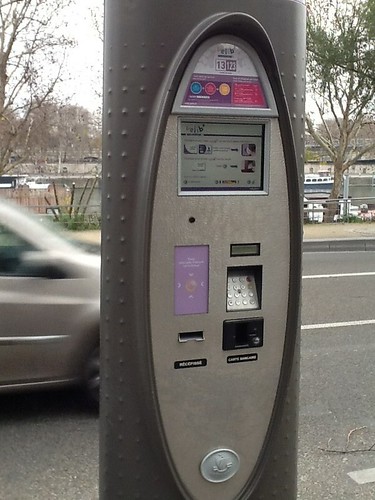
In front of the BnF
Since I have a short term user account with Velibe for using bikes for a week, I just have a subscriber number and pin and have to interact with one of these stations each time I get a bike. Fortunately they have an English option. Also, this one has a different interface than the first ones I used which confused me a little.
Wednesday, November 28, 2012
Velibe Bikeshare Station at BnF
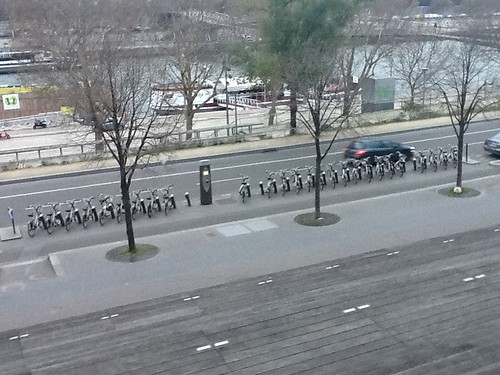
Velibe station, looking down stairs that form the side of the BnF
This is where I drop off my Velibe bike in the morning and pick one up when the workshops are over at the end of the day. So far there are always bikes there. In the morning sometimes the slots are all full! Then there is another station just a few hundred yards (meters) down the same road so I can go down there and it seems to be much less popular so there are more empty slots to drop off a bike.
The Velibe station is between the roadway and a dedicated bike lane that runs left to right (in this image). There is a no bike lane in the opposite direction although there is a lane for cars in that direction, which seems odd to me. Two car lanes and a bike lane in one direction and only one car lane in the other direction. I have seen some bikes going in that direction on the roadway, but some ride down below closer to the river on a path there. I have noticed this a lot - people choose different ways to go the same direction on their bikes. So far as I can tell, the drivers seem not to expect cyclists to stay off the road just because the cyclist has an alternative route away from the road.
When I check a bike out of the BnF station, I have to look back that no cyclist is coming up the bike lane since you back the bike out of its "docking station."
I now appreciate more a well maintained bicycle. The bike I rode back to the hotel today had a broken spoke or something - the rear wheel was quite out of round. Since these bikes have a coaster brake for the the back wheel, it didn't affect braking but it made the ride a little wonky. Others have had different "issues." None have been so much that I turn the bike in to get another one, though. I do check that a bike has air in the tires first but more than that while it is locked up isn't possible.
Saturday, November 17, 2012
Riding in the Cool Rain ~
I have been commuted 10 miles each way to and from work by bike year round for quite a while but only recently put fenders a bike to ride in the rain - boy, does that help a lot! A great improvement.

Presented like this, it seems a bit much
Here is what I wear when the weather is done around 40 and rainy, which it was one day recently.
* Helmet - my everyday helmet. I only have one helmet and it has my required parking sticker on it (rather than put it on a bike, which would be a problem since I have several bikes I ride to/from work).
* Baseball cap - keeps rain from running down my face, which can be very unpleasant in a heavy rain.
* Waterproof rain jacket - I have used something called an "O2 Rainwear Cycling Rain Jacket" from Nashbar for what seems like ten years. This is an extremely lightweight jacket made of some 3M fabric that is good at the waterproof part although it doesn't breathe as well as some more expensive material (I assume). At $30 it comes with a stuff bag and is easy to have along "just in case." The main drawback is that it is fairly fragile material, easy to tear. I have not purchased a more expensive GoreTex sort of jacket because this can be used in layers or by itself and it has worked pretty well so far (and doesn't cost a lot).
* Long sleeve cycling jersey with hood - cheap lycra jersey from PerformanceBike. I like to have a long sleeve jersey like this with a hood since I can take the hood off easily if it is more than needed (or put it on) and the hood keeps wind from going down my neck.
* Short sleeve jersey - Another cheap jersey from Performance, to add a layer if it is 40 or below.
* Long sleeve base layer shirt - For me, a fairly pricey long sleeve thin (not heavy) Merino wool shirt from Ibex. I got this last year - it replaces a layer of polypropylene. Works well.
* Performance bike shorts - The more expensive "Ultra" Performance brand bike shorts last longer and compare with name brand bike shorts. The less expensive Performance brand bike shorts seem shoddy.
* Bicycle tights - I have had these so long I don't remember where they came from. They are just lycra or some lycra cotton mix and aren't waterproof or windproof. When it gets down to freezing I have some more substantial (and expensive) windproof/waterproof tights, but at 40 degrees they are too warm.
* Lightweight wool socks + pair of cotton socks - the shoes I wear in cooler weather are a size large so I can wear more than one pair of socks.
* Shimano RW80 Winter Road Boots - these are something I bought several winters ago in order to stop using summer shoes with various over-shoes and trying to cram extra socks into the shoes. They work quite well, although they are only moderately waterproof. And once they get damp inside, they are very slow to dry out.
* Addidas rubber shoe "booties" - If it is raining more than a drizzle, I usually pull these on.
* Performance Nanuk Waterproof Thermal Gloves - Silly name, but whatever (as they say). Somewhere around 45 I want to have full finger gloves and these are what I wear down to around freezing; cooler than that I want something more serious than these gloves. They aren't really waterproof although it does take a long time for them to get damp all the way through. Unfortunately they take a good long time to dry out.
So there you have it!
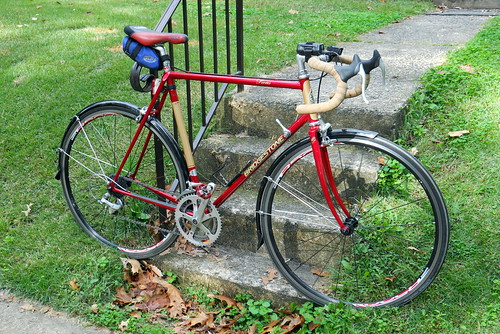
Newly installed fenders on 30 year old bike for rainy weather
The fenders mean that rain doesn't soak my backside; in fact, after ten miles in moderate rain the other day I could sit on a chair and not get the chair damp - pretty good! And the fenders make it a lot easier for the waterproof aspects of my footwear to work successfully - again, the other day when I got to work my socks were dry inside my shoes.

Presented like this, it seems a bit much
Here is what I wear when the weather is done around 40 and rainy, which it was one day recently.
* Helmet - my everyday helmet. I only have one helmet and it has my required parking sticker on it (rather than put it on a bike, which would be a problem since I have several bikes I ride to/from work).
* Baseball cap - keeps rain from running down my face, which can be very unpleasant in a heavy rain.
* Waterproof rain jacket - I have used something called an "O2 Rainwear Cycling Rain Jacket" from Nashbar for what seems like ten years. This is an extremely lightweight jacket made of some 3M fabric that is good at the waterproof part although it doesn't breathe as well as some more expensive material (I assume). At $30 it comes with a stuff bag and is easy to have along "just in case." The main drawback is that it is fairly fragile material, easy to tear. I have not purchased a more expensive GoreTex sort of jacket because this can be used in layers or by itself and it has worked pretty well so far (and doesn't cost a lot).
* Long sleeve cycling jersey with hood - cheap lycra jersey from PerformanceBike. I like to have a long sleeve jersey like this with a hood since I can take the hood off easily if it is more than needed (or put it on) and the hood keeps wind from going down my neck.
* Short sleeve jersey - Another cheap jersey from Performance, to add a layer if it is 40 or below.
* Long sleeve base layer shirt - For me, a fairly pricey long sleeve thin (not heavy) Merino wool shirt from Ibex. I got this last year - it replaces a layer of polypropylene. Works well.
* Performance bike shorts - The more expensive "Ultra" Performance brand bike shorts last longer and compare with name brand bike shorts. The less expensive Performance brand bike shorts seem shoddy.
* Bicycle tights - I have had these so long I don't remember where they came from. They are just lycra or some lycra cotton mix and aren't waterproof or windproof. When it gets down to freezing I have some more substantial (and expensive) windproof/waterproof tights, but at 40 degrees they are too warm.
* Lightweight wool socks + pair of cotton socks - the shoes I wear in cooler weather are a size large so I can wear more than one pair of socks.
* Shimano RW80 Winter Road Boots - these are something I bought several winters ago in order to stop using summer shoes with various over-shoes and trying to cram extra socks into the shoes. They work quite well, although they are only moderately waterproof. And once they get damp inside, they are very slow to dry out.
* Addidas rubber shoe "booties" - If it is raining more than a drizzle, I usually pull these on.
* Performance Nanuk Waterproof Thermal Gloves - Silly name, but whatever (as they say). Somewhere around 45 I want to have full finger gloves and these are what I wear down to around freezing; cooler than that I want something more serious than these gloves. They aren't really waterproof although it does take a long time for them to get damp all the way through. Unfortunately they take a good long time to dry out.
So there you have it!

Newly installed fenders on 30 year old bike for rainy weather
The fenders mean that rain doesn't soak my backside; in fact, after ten miles in moderate rain the other day I could sit on a chair and not get the chair damp - pretty good! And the fenders make it a lot easier for the waterproof aspects of my footwear to work successfully - again, the other day when I got to work my socks were dry inside my shoes.
Saturday, January 28, 2012
Flat Tire Blues?
Really, though, it wasn't so bad . . . or anyway it could have been worse.
Lately I have been commuting every day on my 30 year old Bridgestone. Two weeks ago, I got ready to go and when I put air in the rear tire, it started coming out faster than I could put it in! The edge of the hole in the wheel that the stem passes through had a rough edge that had made a hole in the rubber of the tire that extends a small way up the stem creating a leak. This was not a "puncture" flat of the usual sort but still, flat tires tend to come in "threes" so I guess I wasn't surprised when yesterday I had a flat tire on the way to work.
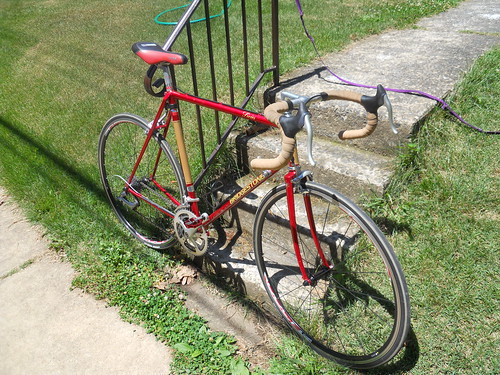
My nice 1982 Bridgestone Sirius, with air in the tires
Before 7 am these days, it is dark out. Plus the weather yesterday was strange - the temperature this early was close to 60 degrees - but rain was threatening so I was pretty sure that stopping to fix a tire was going to increase my chances of getting wet. As it turned out, I was just at where the Four Mile Run trail passes under Route 1 and the GW Parkway near the south end of the airport, so I pulled over between two lights and at least could see what I was doing.
I like to imagine I can fix a flat in ten minutes or less, but it is always more like 15. Off comes the tire and I pull out the tube and mark the tube with my Sharpie as to which side of the tube was which - if I don't do that, then when I find out where the hole is it is just that much more work figuring out if the sharp thing that came through the tire is still there or not. (I never like putting in a fresh tube not knowing what caused a whole in the previous one.) I put some air in the tube and easily found the hole, marked it, then matched it up with the tire and quickly found a very stiff bit of fine wire, say 3/8 inch long, going right through the tire that had punctured the tube. It was nice that there was no damage to the tire at least. Even with Kevlar belts this kind of thing is going to happen, although how this wire had been sitting there on the trail, standing on end waiting for a bike tire to poke into, is hard to imagine. Out comes the wire from the tire, take new tube from tool bag, put wheel back together, fill with air and off I go.

I guess I should have put on some rubber gloves
Nine riders went by while I worked on my tire - none of the fair weather bike commuters out on a day like this! I was a little disappointed that of the nine, five rode by in silence (like I wasn't there) and only four offered to help with the usual "got what you need?" or similar. Of course, to stop on a day like this would be to increase the chances of getting caught in the rain. Not that we are going to melt . . .
Having fixed my flat about three miles into my ten mile ride, I then took off - I found that the wind was from the south (which is unusual at this time of day) and I made good time, although I didn't make up for the 15 minute "break" in my ride! Still, it was exhilarating. As I crossed the 14th St Bridge, I could see rain off to the north, but I got to work without getting caught in the rain. On the way to my office, after parking my bike in the garage, I looked out a window and was surprised to see water sluicing down the windows from a downpour. I don't mind riding in the rain, but not so much downpours, so even with my stop I managed to avoid that. Good!
Almost immediately after broad adoption of pneumatic tires for bicycles in the late 1880s, people began trying to figure out a way to avoid flat tires and yet have the obvious benefits of that kind of tire (as compared to solid rubber or other sold tires).

An example of an 1896 proposed alternative to the pneumatic tire
So far, however, nothing like to replace the pneumatic tire (and inevitable flat tires) has been developed that is widely used.
Lately I have been commuting every day on my 30 year old Bridgestone. Two weeks ago, I got ready to go and when I put air in the rear tire, it started coming out faster than I could put it in! The edge of the hole in the wheel that the stem passes through had a rough edge that had made a hole in the rubber of the tire that extends a small way up the stem creating a leak. This was not a "puncture" flat of the usual sort but still, flat tires tend to come in "threes" so I guess I wasn't surprised when yesterday I had a flat tire on the way to work.

My nice 1982 Bridgestone Sirius, with air in the tires
Before 7 am these days, it is dark out. Plus the weather yesterday was strange - the temperature this early was close to 60 degrees - but rain was threatening so I was pretty sure that stopping to fix a tire was going to increase my chances of getting wet. As it turned out, I was just at where the Four Mile Run trail passes under Route 1 and the GW Parkway near the south end of the airport, so I pulled over between two lights and at least could see what I was doing.
I like to imagine I can fix a flat in ten minutes or less, but it is always more like 15. Off comes the tire and I pull out the tube and mark the tube with my Sharpie as to which side of the tube was which - if I don't do that, then when I find out where the hole is it is just that much more work figuring out if the sharp thing that came through the tire is still there or not. (I never like putting in a fresh tube not knowing what caused a whole in the previous one.) I put some air in the tube and easily found the hole, marked it, then matched it up with the tire and quickly found a very stiff bit of fine wire, say 3/8 inch long, going right through the tire that had punctured the tube. It was nice that there was no damage to the tire at least. Even with Kevlar belts this kind of thing is going to happen, although how this wire had been sitting there on the trail, standing on end waiting for a bike tire to poke into, is hard to imagine. Out comes the wire from the tire, take new tube from tool bag, put wheel back together, fill with air and off I go.

I guess I should have put on some rubber gloves
Nine riders went by while I worked on my tire - none of the fair weather bike commuters out on a day like this! I was a little disappointed that of the nine, five rode by in silence (like I wasn't there) and only four offered to help with the usual "got what you need?" or similar. Of course, to stop on a day like this would be to increase the chances of getting caught in the rain. Not that we are going to melt . . .
Having fixed my flat about three miles into my ten mile ride, I then took off - I found that the wind was from the south (which is unusual at this time of day) and I made good time, although I didn't make up for the 15 minute "break" in my ride! Still, it was exhilarating. As I crossed the 14th St Bridge, I could see rain off to the north, but I got to work without getting caught in the rain. On the way to my office, after parking my bike in the garage, I looked out a window and was surprised to see water sluicing down the windows from a downpour. I don't mind riding in the rain, but not so much downpours, so even with my stop I managed to avoid that. Good!
Almost immediately after broad adoption of pneumatic tires for bicycles in the late 1880s, people began trying to figure out a way to avoid flat tires and yet have the obvious benefits of that kind of tire (as compared to solid rubber or other sold tires).

An example of an 1896 proposed alternative to the pneumatic tire
So far, however, nothing like to replace the pneumatic tire (and inevitable flat tires) has been developed that is widely used.
Sunday, December 11, 2011
Why Cyclists May Avoid "Their" Bike Lanes
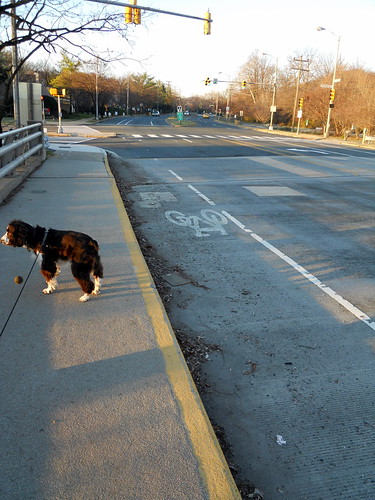
My dog isn't too interested, but the dedicated bike lane has some issues
A classic example of how the bike lane, created with much (ok, not much) fanfare when this bridge was resurfaced a few years ago, has become the place for little trashy crap kicked up by the passing cars - just the sort of thing to flat a bike tire. Mighty convenient for all of it to be stored right there in a special lane just for the bikes (and their tires)!

Close-up shows how much crap is in the bike lane
Subscribe to:
Comments (Atom)
